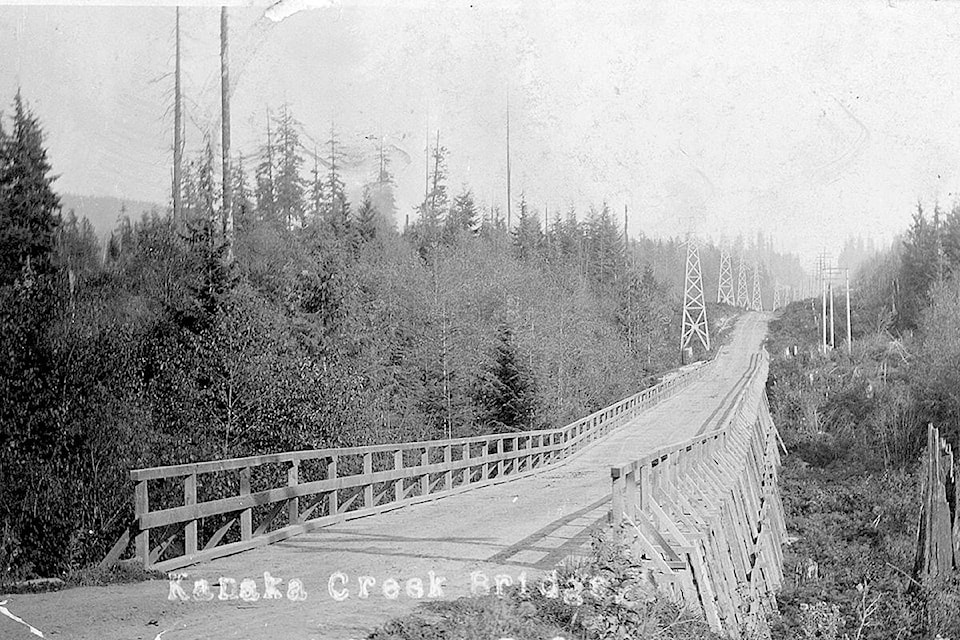By Val Patenaude/Special to The News
The Dewdney Trunk Road – its name and origins – have come up a lot recently, so it seems a good time to revisit the story.
A “Trunk Road” refers to a major route across a large territory that provides access to the parts of that territory in a way that no other route accomplishes.
In modern times, we refer to such routes as “highways” or use other modern terms.
If you think of a trunk road as a trunk of a tree, the idea was that other roads would branch from or cross that main route and continue to expand access to hinterlands.
Maple Ridge council started advocating for a trunk road by 1884.
RECENT LOOKING BACK COLUMN: History never stops – inviting stories from the pandemic
The council of the day unanimously decided that it would be of material advantage to have a trunk road leading through the municipality from a point near Port Hammond station to Stave River.
The clerk was instructed to apply to the government for the necessary funds for the construction of the road and have it located by a competent engineer. [Source: Columbian 1884.04.09]
Extending such a road to Stave River would include all the surveyed townships of Maple Ridge District with the prize at the end being the already planned dam on the Stave.
Access would first be provided to land surveyors and they would be followed by settlers.
In 1884, the whole of Township 12 – which included the vast mid-section of Maple Ridge – remained unsurveyed except along the Fraser River.
The other big selling point was access to the Stave Falls and the planned damming of that gap.
The dam was planned many years before it could be built because of the access challenges. When the dam was completed in 1914, the lines that carried the power to the Lower Mainland were supported by a string of metal towers on the north side of Dewdney Trunk.
In the 1890s, the only passage across this territory was a path along which ox-drawn sledges could be dragged. When James Murray Webster opened up the Webster’s Corners area, all of his family’s belongings and construction materials were dragged in by sledge.
RECENT COLUMN: Roaring in the 1920s
Through the next few years, nothing happened but piece work along the desired route.
The municipality needed the provincial government to provide funding, especially for the bridges – which were always the most expensive parts.
In 1895, a group of anxious landowners petitioned the local government to take out a loan of $50,000 to build the road, but it was not possible as in those days, councils were elected annually and one council could not commit the next council to ongoing debts.
A huge obstacle on the expense side in 1898 was bridging Hick’s Gulf, which was the local name for where Kanaka Creek intersects the trunk road.
By that summer, the provincial government came through and work on that challenging section began.
By 1900, the gravel road from Pitt Meadows to the small town of Dewdney was complete.
The latter was the origin of the name “Dewdney Trunk Road.”
Both the town of Dewdney and the Dewdney Trail were named after Edgar Dewdney. He was an early surveyor who surveyed the Dewdney Trail and later the townsite of New Westminster.
The town of Dewdney was named for him when he became Lieutenant-Governor of BC in 1892. The Dewdney Trunk Road had nothing to do with the Dewdney Trail.
The route west of Pitt Meadows was a bit longer in coming as the Pitt River was far more formidable to bridge than Kanaka and it would be 1915 before that section opened.
– Val Patenaude is director at the Maple Ridge Museum and Archives
.
• If there is more to this issue, please let us know about it. Email us at editor@mapleridgenews.com. We look forward to hearing from you. In the meantime, like us on Facebook or follow us on Twitter.
